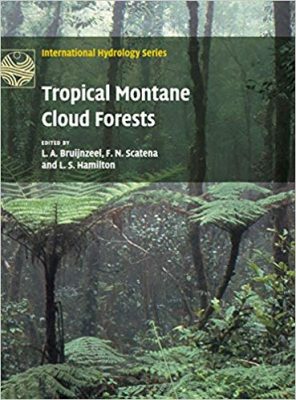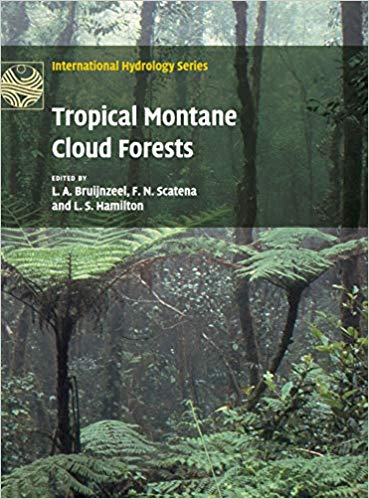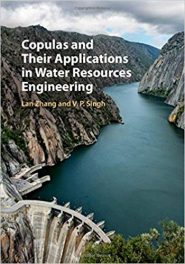 Editors: L.A. Bruijnzeel, F.N. Scatena, and L.S. Hamilton
Editors: L.A. Bruijnzeel, F.N. Scatena, and L.S. Hamilton
Publisher: Cambridge University Press – 740 pages
Book Review by: Sonu Chandiram
This book is part of the International Hydrology Series that was begun in 1975 by the International Hydrology Program or IHP established by the United Nations Educational, Scientific and Cultural Organization (UNESCO).
The long-term goal of the IHP is (as the editors write) “to advance our understanding of the processes occurring in the water cycle and to integrate this knowledge into water resources management. The IHP is the only UN science and education program in the field of water resources, and one of the outputs has been a steady stream of technical and information documents aimed at water specialists and decision makers.”
Montane ecosystems are those found in mountains. These ecosystems are strongly affected by climate. The temperatures in mountains drop at higher elevations, and plants transform into grasslands or tundra. A tundra is a type of biome or low-temperature ecosystem that hinders the growth of trees, with shorter growing periods.
The primary focus of this book is the forests that are found at high elevations of mountains, called ‘cloud forests’ Such forests as they are found in the 27 countries we name below (as well as others) were studied by the numerous content contributors of this book, that has extensive coverage of mountain forests.
This large book is the work of 175 specialists in various fields who were authors or coauthors of its 72 chapters relating to agriculture, agro-ecosystems, air quality, atmospheric sciences, biodiversity, biogeochemistry, biology, botany, climatology, conservancy, Earth sciences, ecology, ecosystems, engineering, the environment, energy, forestry, geography, geology, hydrology, land management, meteorology, natural resources, plant sciences, silviculture, soil science, space technology, water resources, wetlands, wildlife conservation, and zoology.
The contributors hail from 27 countries – Argentina, Australia, Austria, Bhutan, Canada, China, Colombia, Costa Rica, Ecuador, French Polynesia, Germany, India, Japan, Malaysia, Mexico, the Netherlands, Singapore, Spain, Sweden, Switzerland, Taiwan, Tanzania, Thailand, Uganda, the United Kingdom, the United States, and Venezuela.
Too numerous to list all the chapters here, we provide you a broad overview by naming the seven Parts within which they are covered:
- Part I – General Perspectives
- Part II – Regional Floristic and Animal Diversity
- Part III – Hydrometeorology of the Tropical Montane Cloud Forest
- Part IV – Nutrient Dynamics in Tropical Montane Cloud Forests
- Part V – Cloud Forest Water Use, Photosynthesis, and Effects of Forest Conversion
- Part VI – Effects of Climate Variability and Climate Change
- Part VII – Cloud Forest Conservation, Restoration, and Management Issues
The editors write: “This book is a must-have for anyone interested in the study, conservation, management, or restoration of tropical montane cloud forests. It represents the state of the art with respect to our knowledge of cloud forest occurrence and status, as well as the biological and hydrological value of the unique forests.”
The editors and authors have taken a practical approach and emphasis in writing about what scientific knowledge has been gathered by numerous specialists and sub-specialists and is known. But a lot is still not known and research continues in order to fulfill the long-term goals of the IHP we have mentioned above
This is an important contribution to the worldwide need for a better understanding of climate change that has adversely affected humans and animals, and forms an important basis for ongoing research and conservation efforts.
The final chapter is an essential, summarizing and synthesizing one that needs to be thoroughly read and understood because it provides critical facts and a strong foundation for moving forward with action.
Editors:
Leendert Adriaan (Sampurno) Bruijnzeel is a Professor of Land Use and Hydrology based at Vrije Univeriteit (VU) in Amsterdam in the Netherlands. He has 35 years of experience with forest hydrological research in the humid tropics, mainly Southeast Asia, the Caribbean, and Latin America. His main research interests include the water and nutrient dynamics of tropical forests, above all montane cloud forests.
Frederick N. Scatena is a Professor and Chair of the Department of Earth and Environmental Science at the University of Pennsylvania. Since 1988 he has served as the co-Principal Investigator of the Luquillo Long-Term Ecological Research Project of the National Science Foundation (NSF) and since 2009 as the Lead PI of the NSF Luquillo Critical Zone Observatory.
Lawrence S. Hamilton is a Professor Emeritus at Cornell University and former Senior Fellow at the East-West Center in Hawaii. He has authored over 900 publications throughout his career and is known popularly as ‘the father of cloud forests’ due to his successful campaign over many years to get these forests to get these forests on the international conservation agenda.







